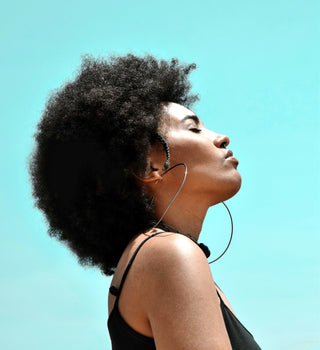While embracing your natural, non-chemically treated hair is a beautiful journey, identifying your specific hair type can greatly enhance your hair care routine and styling options. From straight strands to coiled curls, each hair type has unique characteristics that impact how it looks, feels, and styles. Let's explore the different hair types and what sets them apart.
Type 1 Hair: Straight and Sleek Type 1 hair is characterized by its naturally straight texture, devoid of any visible curls or waves. Although some may question whether straight hair qualifies as "natural," genetics and careful maintenance can result in naturally straight strands. Type 1 hair typically appears sleek and smooth, with strands lying flat against the scalp. When wet, type 1 hair maintains its straightness and may become even smoother. Styling type 1 hair is relatively straightforward, as it tends to hold styles well and can easily be manipulated into various looks.
Type 2 Hair: Loose Waves Type 2 hair encompasses a range of loose wave patterns, from subtle bends to more defined waves. Unlike straight hair, type 2 strands have a gentle undulation that adds volume and movement. Type 2A hair features loose, tousled waves that cascade effortlessly, while type 2B hair exhibits slightly tighter waves with more body and texture. Type 2C hair, on the other hand, boasts defined waves that border on curls, offering a balance between waves and ringlets. When wet, type 2 hair retains its wave pattern, becoming more defined and voluminous as it dries. Styling type 2 hair often involves enhancing and accentuating its natural texture through gentle manipulation and the use of styling products.
Type 3 Hair: Spiraled Curls Type 3 hair is characterized by its spiral curl pattern, which ranges from loose curls to tighter coils. These curls typically form from root to end, creating a voluminous and textured appearance. Type 3A hair features loose, elongated curls with a soft S-shaped pattern, while type 3B hair boasts tighter curls that resemble corkscrews. Type 3C hair represents the tightest curl pattern within this category, with coils that are densely packed and springy. When wet, type 3 hair springs to life, showcasing its natural curl pattern and elasticity. As it dries, the curls may shrink slightly, resulting in a more compact and defined look. Styling type 3 hair often involves techniques such as finger coiling, twist-outs, and bantu knots to enhance and define the curl pattern.
Type 4 Hair: Coily and Textured Type 4 hair encompasses a diverse range of coily and textured hair patterns, commonly referred to as "kinky" or "Afro-textured" hair. Unlike the defined curls of type 3 hair, type 4 strands form tight coils and zigzag patterns that create volume and dimension. Type 4A hair features coils that are small and tightly wound, resembling the circumference of a crochet needle. Type 4B hair exhibits coils that are more densely packed and may appear zigzag-shaped or angular. Type 4C hair represents the tightest and most densely coiled texture, with coils that may appear closely spaced and compact. When wet, type 4 hair may shrink significantly, revealing the true length of the strands as they dry. Styling type 4 hair often involves techniques such as twist-outs, braid-outs, and wash-and-go styles to enhance definition and manageability.
Understanding your hair type is essential for tailoring your hair care routine to meet the unique needs of your strands. By observing how your hair behaves when wet versus dry and experimenting with different styling techniques, you can better understand and embrace your natural hair texture. Whether you have loose waves or tight coils, each hair type is a beautiful expression of your individuality and deserves to be celebrated.
Celebrate Your Natural Hair: Join the Conversation
In this exploration of natural hair types, we've delved into the diverse textures that adorn our heads, from straight strands to coily coils. Now, it's your turn to share your thoughts and experiences!
What is the best part about your hair type? Do you love the versatility of your waves, the definition of your curls, or the volume of your coils? Join the conversation and let us know what makes you proud to rock your natural hair. Whether you have tips to share, questions to ask, or simply want to celebrate the beauty of diverse hair textures, we invite you to share your voice in the comments below. Let's continue to uplift and empower each other on our natural hair journeys!

